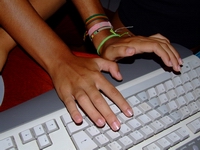Effective E-mail Messages
Technology can be a boon or bust when contacting your professor. While e-mail can be the best way to communicate, following a few simple rules will make it easier for your professor to respond to you.
Clear and Concise
E-mail messages like well written essays should be clear and concise. But don't be so concise that your question is vague. To write, "I don't understand this class" is not a comment to which your professor can reasonably respond. "I am having difficulty understanding how to do ___________" is much better. Be sure to specifically mention the class about which you are writing.
Formality Counts
When you write to your professor, you are engaging in business correspondence; a type of correspondence that requires more formal language than might be expected in a note to a friend or in a text message. Use complete sentences and proper grammar. Also, you should avoid abbreviations such as "Gr8" for "great" and "IC" for "I see" or "4" for "four."
Subject Line
Always include a subject line with your e-mail message because messages without subject lines are often deleted. When writing your subject line, you need to balance brevity and clarity. For example, "Help" is too brief, while "Help needed on Assignment 3" is better.
It is a good idea to begin your subject line with the course number. For example, if you have enrolled in my film class, you should begin your subject line with "ENG 200."
The software that Schoolcraft College professors use to manage their e-mail allows them to sort software by the subject line. Therefore, you should follow any directions your instructor gives you for the subject line exactly as they are given.
Even if your professor does not require it, it is a good idea to begin your subject line with the course number. For example, an e-mail sent to an instructor of an early American history course should begin HIST 151.
Finally, make sure that your subject line matches the topic of your e-mail.
Sign Your E-mail
Always sign your e-mail messages with both your first and last name.
Sign Attachments
Even if you sign your e-mail message, always sign any assignments you include as attachments. If your instructor prints out your homework to grade later, she or he might not be able to figure out that it was your homework unless your name appears on it.
Please note that it is assumed that you will include a message with your attachment. Because of the problem created by viruses, only a very foolish person would open a document attached to an unsigned e-mail or an e-mail that included no message. It is reasonable for your professor — or anyone else for that matter — to simply delete an e-mail that has no message.
One Subject Per E-Mail
Generally, it is best to include only one subject per e-mail message. Don't turn in Homework Assignment #4 and ask a question about the previous class in the same message. Instead, send two separate e-mail messages.
Replying to E-Mail
Be sure to include a copy of his or her message with your e-mail when you are responding to an e-mail from your instructor. This will give a context for your question and make it easier for your professor to give you a response.
Save Your E-Mail
During the course of the semester, be sure to save all of the e-mail you send and receive from your professor. And before writing to your professor, be sure to re-read relevant messages that were previously sent or received.
Consider Your E-mail Address
You might want to consider what type of message your e-mail address says about you. For example, do you want your professor to think of you as "Livonia-stud" or "Plymouth-party-girl" when they are answering your e-mail? Although the faculty at Schoolcraft College will not react negatively to such names, this might not be the case if you are using your account for other business reasons. Could presenting yourself as "Satan's-Helper" affect your ability to get a job?
Printer Friendly Version
Download a printer friendly copy of "Effective E-mail Messages."
